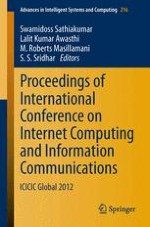2014 | Book
Proceedings of International Conference on Internet Computing and Information Communications
ICICIC Global 2012
Editors: Swamidoss Sathiakumar, Lalit Kumar Awasthi, M. Roberts Masillamani, S S Sridhar
Publisher: Springer India
Book Series : Advances in Intelligent Systems and Computing
